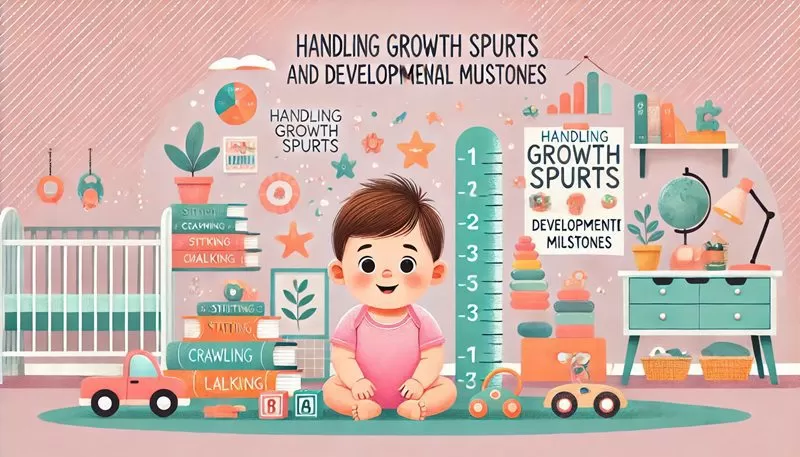Table of Contents
Growth Spurts Developmental Milestones
Every parent knows that babies grow up fast, but when those growth spurts hit, it can feel like your little one is changing overnight. Growth spurts and developmental milestones are natural parts of your baby’s journey, but they can also be challenging times. In this comprehensive guide, we’ll help you understand the stages of growth spurts, what to expect during developmental milestones, and how to support your baby through these critical phases. Along the way, we’ll introduce you to some must-have products from [your store] that can make managing these periods easier and more enjoyable.
Understanding your baby’s growth spurts and developmental milestones is essential for ensuring their healthy development. Growth spurts can happen at any time, and knowing how to handle them can make a big difference. According to this resource from the American Academy of Pediatrics, recognizing signs of a growth spurt early can help you stay prepared and support your child’s evolving needs. This guide offers expert advice on nurturing healthy baby development, helping parents stay informed about every stage of their child’s growth.
What You Need to Know About Baby Growth Spurts

Growth spurts are short periods when your baby grows rapidly in both height and weight. These spurts can happen suddenly, often leaving parents surprised at how much their little one seems to change in just a few days. Babies may become fussier during growth spurts, eat more, and sleep less (or sometimes more), making it a stressful time for both the baby and parents.
During a growth spurt, your baby might demand extra feedings, either because they need more calories or as a way to self-soothe. If you’re breastfeeding, you might notice your baby wanting to nurse more often. Having products like our Breastfeeding Pillow can make these frequent feedings more comfortable for both you and your baby, ensuring proper support and posture.
Signs of a Growth Spurt:
- Increased hunger
- Restlessness or fussiness
- Changes in sleep patterns
- Sudden weight gain or length increase
Growth spurts usually occur around 3 weeks, 6 weeks, 3 months, and 6 months of age. These periods are critical for your baby’s physical and brain development, so be prepared for some sleepless nights and extra feeding sessions.
As your baby grows and experiences developmental milestones, it’s common for their sleep patterns to change, which can leave parents feeling exhausted. Growth spurts often lead to more frequent nighttime wake-ups, making it essential for caregivers to find ways to cope with the inevitable lack of rest. If you’re struggling with sleep deprivation, check out our guide on How to Deal With Sleep Deprivation After Baby for practical tips to help you stay energized and healthy during this challenging time.
Understanding Infant Growth Spurts: Everything You Need to Know

When dealing with infant growth spurts, it’s important to understand what’s happening in your baby’s body. Growth spurts aren’t just about physical changes; they’re also linked to developmental milestones such as rolling over, sitting up, and eventually walking. As your baby’s body and brain develop, they might need more nutrients and sleep.
Providing your baby with nutrient-rich food, whether through breast milk, formula, or solids, will ensure they are getting everything they need to support their growth. For babies who are starting solids, products like our Baby Food Storage Containers are great for preparing meals in advance, helping you keep track of portions and nutrition.
Pro Tip: Make sure to track your baby’s growth and developmental milestones in a baby journal. Not only does this help you stay on top of your baby’s health, but it’s also a precious keepsake for the future.
Supporting Your Baby Through Developmental Milestones

Developmental milestones are the physical, cognitive, and emotional changes your baby experiences as they grow. These milestones are often exciting and can include big moments like the first smile, first words, and first steps. Each baby is unique, and while milestones typically follow a general timeline, your little one may hit them earlier or later than expected.
Milestones to Watch For:
- 1 to 3 months: Smiling, tracking objects with their eyes, lifting their head.
- 4 to 6 months: Rolling over, sitting up with support, beginning to babble.
- 7 to 9 months: Crawling, pulling up to stand, exploring with hands and mouth.
- 10 to 12 months: Walking with help, saying simple words like “mama” and “dada.”
Each milestone can bring new challenges. For instance, when your baby starts crawling or walking, baby-proofing your home becomes a top priority. Our Safety Corner Protectors can help keep sharp edges safe, preventing injuries as your little one begins to explore the world around them.
All About Baby Growth Spurts: What to Expect

Growth spurts are often accompanied by fussiness, disrupted sleep, and increased hunger, but knowing that these behaviors are temporary can help ease your worries. If your baby is crying more than usual, it might be due to the discomfort of rapid growth. During this time, it’s important to be patient and flexible with your routine.
Tips for Managing Growth Spurts:
- Stay flexible: Your baby might need more frequent feedings or naps, so be ready to adjust your schedule.
- Comfort is key: Growth spurts can be uncomfortable for babies. Offer extra cuddles, soothing routines, or use products like our Swaddle Blankets to help them feel secure.
- Monitor for other changes: If your baby’s fussiness continues for longer than a growth spurt typically lasts (usually a few days to a week), consult your pediatrician to rule out other issues.
By understanding that these behaviors are part of your baby’s natural development, you can navigate growth spurts with more ease and less stress.
Managing Diaper Blowouts and Leaks can be a real challenge for parents, especially during growth spurts when your baby may be eating more and creating bigger messes. Ensuring the right diaper fit is crucial, as babies grow quickly, and diapers that are too small or too large can lead to leaks. Investing in high-quality diapers and properly securing them can make a huge difference. Consider adding diaper covers or using absorbent inserts for extra protection during naps or overnight. With the right tools, you can minimize the stress of frequent changes and keep your baby dry and comfortable throughout their day.
How to Handle Fussiness During Growth Spurts

During a growth spurt, it’s not unusual for babies to become clingier and fussy. They may demand more attention, and their usual soothing techniques may not work as effectively. This period can be challenging, but having a few calming tricks in your toolkit can make a big difference.
- Create a calm environment: Reduce noise and bright lights, especially if your baby seems overstimulated. A peaceful atmosphere can help them relax.
- Offer comfort items: Soft toys or blankets, like our Comfort Cuddle Blanket, can help soothe your baby during stressful moments.
- Stick to a routine: While you may need to adjust your daily schedule, maintaining a predictable routine around feeding and napping can give your baby a sense of security during these growth spurts.
As your baby navigates growth spurts and developmental milestones, it’s important to stay informed about common health concerns that may arise. One such condition is jaundice in newborns, which can occur shortly after birth. Understanding the symptoms, causes, and treatments for jaundice is crucial for ensuring your baby’s health and well-being during these pivotal stages. For a deeper dive into jaundice and how to address it, check out our detailed guide on Jaundice in Newborns – Symptoms, Causes, and Treatment
What You Need to Know About Baby Growth Spurts

Growth spurts can be intense, but they are also short-lived. Most spurts last just a few days, during which your baby may seem hungrier, more tired, or more irritable than usual. While the growth spurt itself might feel overwhelming, remember that these moments are crucial for your baby’s development. During these times, you’ll likely see your baby hitting new developmental milestones shortly after.
Some parents worry that frequent growth spurts mean their baby isn’t getting enough food, but in most cases, this increased hunger is temporary. Trust your baby’s cues and feed them as needed, whether that means offering more breast milk, formula, or solid foods. Keeping your baby well-nourished and comfortable during these phases will help them thrive through their growth spurts.
When you’re navigating growth spurts and developmental milestones, traveling with your baby can add a layer of complexity. Ensuring you have the right gear can make all the difference, from keeping your little one comfortable during long trips to maintaining a sense of normalcy in unfamiliar environments. For a comprehensive guide on How to travel with a baby, and the gear you need, check out this helpful resource that covers everything from packing tips to must-have travel items.
All About Baby Growth Spurts: Final Thoughts
While growth spurts can be difficult, they are a clear sign that your baby is growing healthily and progressing toward important developmental milestones. Be patient with yourself and your baby during these times. Remember, growth spurts won’t last forever, and with the right tools and knowledge, you’ll handle them like a pro.
Take time to rest when you can, and ensure that you and your baby have everything needed to get through these stages smoothly. Products like our Comfort Cuddle Blanket, Ergonomic Baby Carrier, and Baby Food Storage Containers can make these transitions easier and more comfortable for both of you.
Key Phrases Recap:
- What You Need to Know About Baby Growth Spurts
- Understanding Infant Growth Spurts: Everything You Need to Know
- All About Baby Growth Spurts

